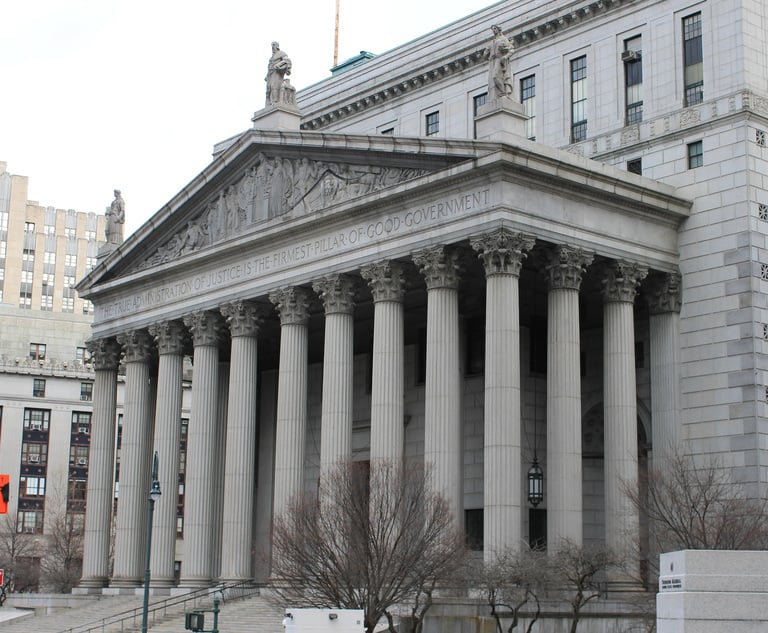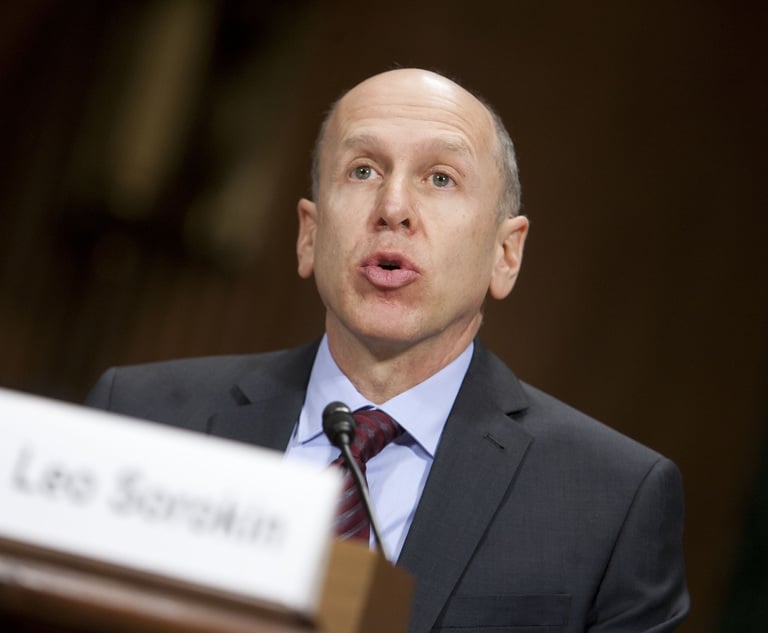Term Limits, 11 Justices, Balancing & More: Reshaping SCOTUS Is in Vogue
Court balancing. Term limits. And more. What follows is a quick look at four proposals—from progressives—to change the U.S. Supreme Court.
October 16, 2018 at 01:37 PM
6 minute read
 U.S. Supreme Court. Credit: Mike Scarcella / NLJ
U.S. Supreme Court. Credit: Mike Scarcella / NLJ
The bitter confirmation of Justice Brett Kavanaugh has ramped up a debate, once only the stuff of academic musings, over how to tamp down the hyper-partisan confirmation process.
Progressives, frustrated that the U.S. Senate in 2016 blocked Barack Obama's nomination of Merrick Garland to the high court and fearing a rightward shift at the court, are leading the dialogue for—and against—various longshot proposals. And all of it hinges on Democrats winning control of Congress and the White House.
Eighteen-year term limits for the justices are in focus. Changing the size of the Supreme Court—adding two justices, for instance—is being floated now in newspaper columns, law review articles, podcasts and blog posts. What follows is a quick look at four debated proposals to change the Supreme Court.
18-Year Term Limits
In his book, “The Confirmation Mess,” Yale Law School's Stephen Carter suggested term limits of eight or 12 years for justices. But in a recent column Carter said he now thinks nine years is better—a vacancy every single year. “No president will be tempted to create a judicial legacy by choosing nominees who will serve for decades; no opponent will see the confirmation of the wrong nominee as a lost opportunity that will not present itself again for a long time,” Carter wrote.
Most term limit proponents, however, seem to have settled on an 18-year, non-renewable term, which would create a vacancy every two years. As one proponent, Alan Morrison of George Washington University School of Law, wrote recently, “There would still be battles over particular nominees, but the shorter length of the appointment and the realization that regular opportunities are certain to arise after the next presidential election might reduce the rancor and perhaps produce more centrist justices.”
Writing at the Washington Examiner last month, Anthony Marcum said 18-year term limits “would make the Supreme Court an issue in every single campaign cycle.” Marcum also argued that post-Supreme Court planning—while still on the bench—poses “real dangers.” He wrote: “With new light at the end of the tunnel, there is little to stop justices from using their position on the Supreme Court to launch these post-judicial aspirations.”
'Term Delays'
The University of Chicago Law School's Daniel Hemel suggests that instead of limiting the justices' terms, their start dates should be delayed. The president still would appoint a justice to fill a vacancy, but the new justice would not take his or her seat until that president leaves the White House.
“We would never need to worry about a justice bowing to the president who appointed her, because the justice would not take the bench until that president left office,” Hemel wrote recently. “And we would never need to worry about a president appointing a justice in order to advance his administration's immediate agenda, because the appointee would not become a justice until that president's administration is over.”
Court Packing
Nothing in the Constitution sets the number of justices at nine. President Franklin Roosevelt's attempt to increase the size of the Supreme Court in order to put his New Deal proposals into effect is getting considerable attention now. But as several historians have noted, other presidents, with Congress' help, have tinkered with the court's size.
Harvard Law School's Michael Klarman recently added his support to expansion of the court's size by Democrats, if they regain political control of Congress and the White House. “Adding one justice would be an obvious and eminently equitable solution to Mitch McConnell's theft of the seat President Obama nominated Merrick Garland to fill,” Klarman wrote. “But Democrats should not stop there.”
Most of the proposals to increase the size of the court settle on 11 justices. But Jacob Russell at Rutgers University School of Law suggests 27 is “a good place to start,” or even higher, with a phased-in process of perhaps two new justices every other year. Larger bodies, he wrote, are more representative, do more work, have fewer narrow and arbitrary splits, have more regular turnover, and “any one vacancy would not dominate the political scene as it does today.”
Princeton University professor Julian Zelizer, writing at The New York Times this week, said any push by Democrats to pack the Supreme Court would backfire.
“Given that the Republicans have tended to care about the courts more than liberals, it is likely that court packing could be more effective at energizing Republicans than Democrats,” Zelizer wrote. “Even if there is a Democratic Congress before 2020, proponents will never find the two-thirds support needed to overturn a presidential veto.”
In July, the libertarian scholar Ilya Somin, writing at the blog Volokh Conspiracy, called the liberal court-packing talk “dangerously misguided.” He said that certain rights progressives champion—including same-sex marriage and reproductive freedom—”would be far more imperiled if the entire institution of judicial review is gutted by court-packing.” He added: “That would ensure that these rights would never again get significant judicial protection—at least not if their adversaries control Congress and the White House.”
Court Balancing
Democrats should campaign in 2020 on a temporary court balancing proposal, according to Ian Ayres and John Witt of Yale Law School. If Democrats win control of Congress and the presidency in 2020, their plan would rectify what happened to Garland's failed nomination in 2016. The court's size would be increased by two federal judges who, by law, would sit on the high court for 18 years and after that term, would serve for life tenure on the lower federal courts.
“The party should commit to nominate one liberal (say, the liberal analog of Justice Neil M. Gorsuch) and to fill the other spot by renominating the liberal-centrist Garland himself,” Ayres and Witt wrote. “The GOP could choose to run on its own platform of court expansion. The deciders would be the American people.”
Read more:
Meet the Ex-Kirkland Partner Up for Next White House Counsel
Jones Day Again Tops Trump Campaign's Legal Billing, New FEC Filings Show
This content has been archived. It is available through our partners, LexisNexis® and Bloomberg Law.
To view this content, please continue to their sites.
Not a Lexis Subscriber?
Subscribe Now
Not a Bloomberg Law Subscriber?
Subscribe Now
NOT FOR REPRINT
© 2025 ALM Global, LLC, All Rights Reserved. Request academic re-use from www.copyright.com. All other uses, submit a request to [email protected]. For more information visit Asset & Logo Licensing.
You Might Like
View All

Trump's DOJ Delays Releasing Jan. 6 FBI Agents List Under Consent Order
3 minute read

Judge Grills DOJ on Trump’s Birthright Citizenship Executive Order
Trending Stories
- 1'Translate Across Disciplines': Paul Hastings’ New Tech Transactions Leader
- 2Milbank’s Revenue and Profits Surge Following Demand Increases Across the Board
- 3Fourth Quarter Growth in Demand and Worked Rates Coincided with Countercyclical Dip, New Report Indicates
- 4Public Notices/Calendars
- 5Monday Newspaper
Who Got The Work
J. Brugh Lower of Gibbons has entered an appearance for industrial equipment supplier Devco Corporation in a pending trademark infringement lawsuit. The suit, accusing the defendant of selling knock-off Graco products, was filed Dec. 18 in New Jersey District Court by Rivkin Radler on behalf of Graco Inc. and Graco Minnesota. The case, assigned to U.S. District Judge Zahid N. Quraishi, is 3:24-cv-11294, Graco Inc. et al v. Devco Corporation.
Who Got The Work
Rebecca Maller-Stein and Kent A. Yalowitz of Arnold & Porter Kaye Scholer have entered their appearances for Hanaco Venture Capital and its executives, Lior Prosor and David Frankel, in a pending securities lawsuit. The action, filed on Dec. 24 in New York Southern District Court by Zell, Aron & Co. on behalf of Goldeneye Advisors, accuses the defendants of negligently and fraudulently managing the plaintiff's $1 million investment. The case, assigned to U.S. District Judge Vernon S. Broderick, is 1:24-cv-09918, Goldeneye Advisors, LLC v. Hanaco Venture Capital, Ltd. et al.
Who Got The Work
Attorneys from A&O Shearman has stepped in as defense counsel for Toronto-Dominion Bank and other defendants in a pending securities class action. The suit, filed Dec. 11 in New York Southern District Court by Bleichmar Fonti & Auld, accuses the defendants of concealing the bank's 'pervasive' deficiencies in regards to its compliance with the Bank Secrecy Act and the quality of its anti-money laundering controls. The case, assigned to U.S. District Judge Arun Subramanian, is 1:24-cv-09445, Gonzalez v. The Toronto-Dominion Bank et al.
Who Got The Work
Crown Castle International, a Pennsylvania company providing shared communications infrastructure, has turned to Luke D. Wolf of Gordon Rees Scully Mansukhani to fend off a pending breach-of-contract lawsuit. The court action, filed Nov. 25 in Michigan Eastern District Court by Hooper Hathaway PC on behalf of The Town Residences LLC, accuses Crown Castle of failing to transfer approximately $30,000 in utility payments from T-Mobile in breach of a roof-top lease and assignment agreement. The case, assigned to U.S. District Judge Susan K. Declercq, is 2:24-cv-13131, The Town Residences LLC v. T-Mobile US, Inc. et al.
Who Got The Work
Wilfred P. Coronato and Daniel M. Schwartz of McCarter & English have stepped in as defense counsel to Electrolux Home Products Inc. in a pending product liability lawsuit. The court action, filed Nov. 26 in New York Eastern District Court by Poulos Lopiccolo PC and Nagel Rice LLP on behalf of David Stern, alleges that the defendant's refrigerators’ drawers and shelving repeatedly break and fall apart within months after purchase. The case, assigned to U.S. District Judge Joan M. Azrack, is 2:24-cv-08204, Stern v. Electrolux Home Products, Inc.
Featured Firms
Law Offices of Gary Martin Hays & Associates, P.C.
(470) 294-1674
Law Offices of Mark E. Salomone
(857) 444-6468
Smith & Hassler
(713) 739-1250








